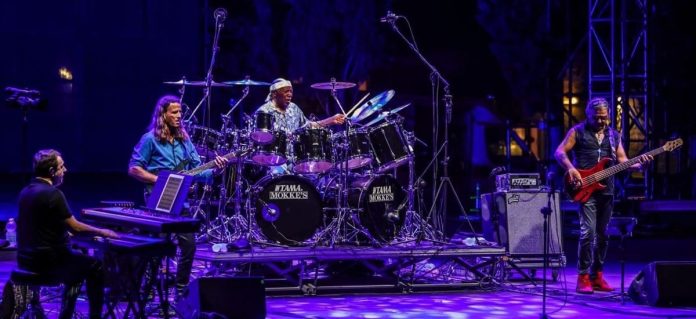
Plenty of American jazz legends have been of sons of Sicily, including Frank Sinatra and Tony Bennett, who’ve both appeared with Palermo’s Orchestra Jazz Siciliana (OJS).
Since the 1970s, the Sicilian capital has hosted top-notch jazz, with the OJS featuring soloists such as Miles Davis, Ornette Coleman, Charles Mingus and Sun Ra, as well as Carla Bley, with whom they recorded for ECM.
The first-ever Sicilia Jazz Festival, with the 18-piece OJS as house band, didn’t feature anyone as trailblazing as those figures. Dutch free-jazz drummer Han Bennink, whose Instant Composers Pool closed the week-long festival on 19 September, comes close, as does fusion drum giant Billy Cobham.
Muscular and energetic at 77, Cobham is still going strong – though naturally not quite as blindingly fast as during his days with Davis and the Mahavishnu Orchestra, when he presaged drum ’n’ bass by decades (his sound has been emulated and sampled ever since, including by Massive Attack on their debut 30 years ago).
At the open-air Teatro di Verdura, he showed a more thoughtful, meditative approach, with the same precision and sense of power in reserve as ever. His solos were pure pleasure and highly musical, with Cobham playing tunes across his massive drum kit, at one point reaching such ferocity that a high-hat stand flew off the drum riser.
Some of his proggy 70s warhorses like Red Baron dragged though, and Jean-Marie Ecay’s rote, bombastic guitar riffs didn’t help. Ecay showed a more delicate side on Panama, Cobham’s 2008 tribute to his birthplace. Scottish keyboardist Steve Hamilton and French bassist Fifi Chayeb were more subtle and eloquent throughout.
With Cobham providing a link to Mahavishnu and the Bitches Brew band, Friday-night headliner Richard Bona provided one to that other fusion behemoth, Weather Report.
Having started out on balafon in his native Cameroon, Bona discovered jazz and switched to electric bass thanks to Jaco Pastorius, whom he honoured here with a metallic-edged version of Teen Town.
Before the show, Miami-based Bona explained that he now holds US and Ghanaian passports after being declared persona non grata due to his criticism of Cameroon’s long-time dictator. After the hottest day in Palermo, with temperatures in the 30s and warm winds blowing from the south, Africa felt very close.
A multi-instrumentalist and Youssou N’Dour-like singer, Bona has a wide stylistic range, having played with Salif Keita and Manu Dibango as well as Branford Marsalis, Chaka Khan, Bobby McFerrin, Harry Belafonte and Pat Metheny.
His natural bond with Caribbean and Latin music threaded through the set, with the rollicking sing-along O Sen Sen Sen sounding like Buena Vista Social Club meets Sonny Rollins calypso. Bona even convincingly delved into Indian music with Shiva Mantra, which he wrote and recorded in Mumbai.
With his Cuban band members unable to enter Italy, Bona was ably backed by a hastily assembled Italian trio including Sicilian keyboardist Seby Burgio, spotted at a master class a few days earlier in Naples. After just one rehearsal, the band was tight and energetic, with saxophonist Luigi Patiemo evocatively switching to flute on several tracks.
More local talent was on display at the Verdura when vocalist Mario Biondi led the OJS in a tribute to Al Jarreau. With the bar of expectations set low for a non-Jarreau fan like me, the show was enjoyable enough, Jarreau’s falsetto hits sounding better in Biondi’s baritone. Biondi handed the spotlight to four female backing singers for a vocalise version of Dave Brubeck’s Blue Rondo À La Turk, followed by Chick Corea’s Spain as an extended, impressive set piece. Unfortunately the show didn’t end there, but instead went downhill with a syrupy version of Billy Joel’s Just the Way You Are.
Sicilian jazz was also showcased at three smaller venues in the city’s historic centre, where marching bands strolled the cobblestoned lanes and concert footage was projected on ancient walls. These early evening shows centred on students and teachers from local conservatories – most of whom were surprisingly good.
These venues were stars in themselves, especially the Santa Maria dello Spasimo (aka Swoon of the Virgin), a Late Gothic church started in 1509 but never completed. Its walls soared to a high open roof, providing dramatic acoustics and visuals, complete with crows cawing in the ruins.
One evening there, Erykah Badu-influenced vocalist Alexandra Manduca sang with Mario Caminita’s Urban J Quintet, mixing acid jazz, funk and soul while occasionally veering too close to Kenny G and Spyro Gyra territory for my taste. Along with a tasteful reworking of Marvin Gaye’s Got To Get It Up, most interesting were South Asian sounds and vocal samples, including the calls of sailors and fishermen in a piece named after nearby Mondello beach.
Playing more tentatively at the same venue were Arabella & the Kids, a young student trio led by double bassist and singer Arabella Rustico. She pleasantly cooed her way through standards and bossa-nova tunes, with guitarist Bruno Crescente taking the mic for a phonetic Ac-Cent-Tchu-Ate The Positive. Edoardo Donato’s alto ornamentation didn’t disrupt the light, easy-listening sound as the crowd sipped Aperol spritzes.
Most impressive, despite its unpromising name, was the TJDP Toscanini Jazz Department Professors, a quintet of youthful teachers who played the Teatro Santa Cecilia. The rhythm section and vibraphonist kept a low profile, supporting the interplay between sensitive pianist Valerio Rizzo and vocalist Ernesto Marciante. This extraordinary scat singer brought to mind Chet Baker’s Italian years, complete with a startling, non-gimmicky “trumpet solo” on his swinging hepcat serenade, Musicista Di Quartiere (Neighbourhood Musician). The overall effect was masterful and stylish, much like the festival as a whole.
















